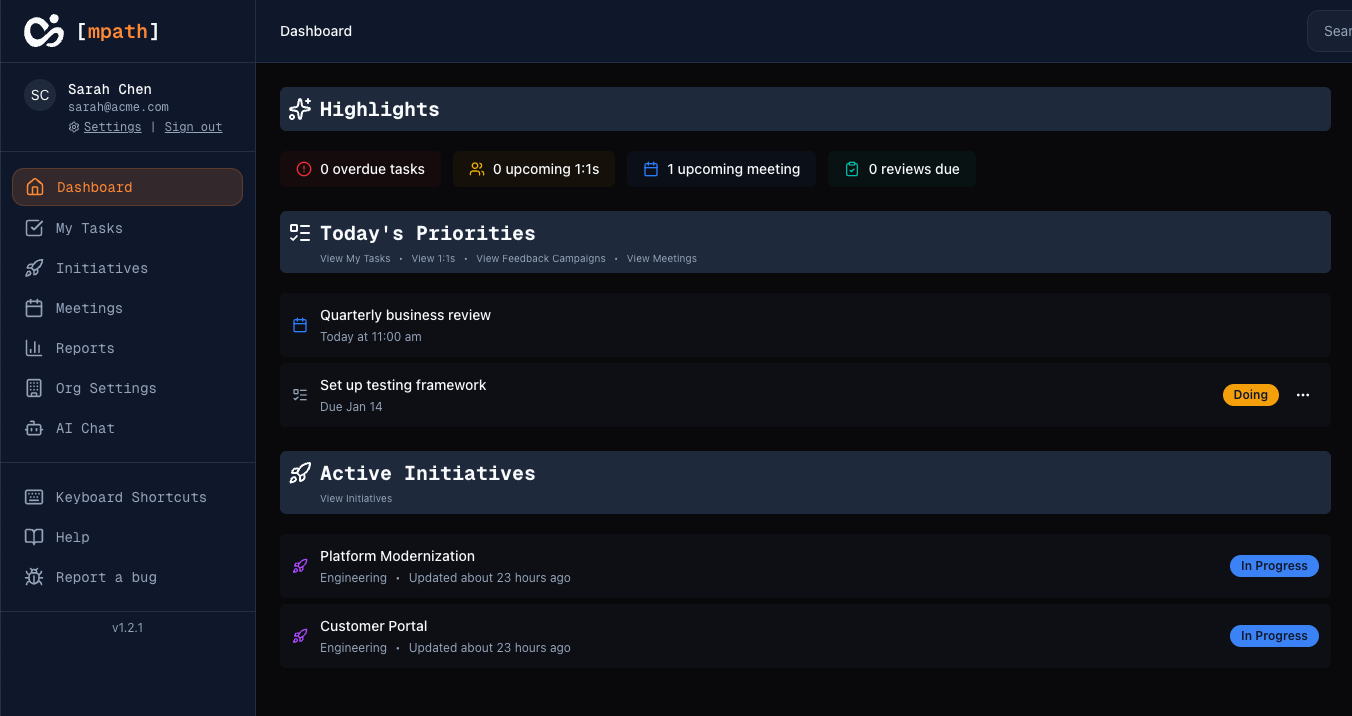Building mPath: A Tool for Managing the Chaos
I’ve been working on a tool meant to help me as an engineering manager, but somewhere along the way I realized it could be helpful to others too.
Building it forced me to step back and think about where an engineering manager’s pain points are most pronounced. What I kept coming back to were two things: tracking large-scale initiatives over time, and understanding the health and happiness of the team. They’re connected, but distinct enough to deserve their own focus.
Initiatives
I like to organize work into larger, more meaningful efforts that have impact beyond a single ticket or epic. These are initiatives — structured around objectives, measurable outcomes, and clear connections to the organization’s broader goals.
Different companies might call them programs, themes, or OKRs, but the essence is the same. As managers, we owe our teams clarity on the what and why behind the work. That clarity helps people see their impact, and it helps me see mine.
I wanted each initiative in mPath to be connected to people, tasks, and meetings, so I could go to one place and instantly understand what’s happening: what it’s for, who’s involved, and what’s being discussed.
I know some organizations already have pristine documentation, unified tools, and consistent alignment across every team. I haven’t worked at that company yet.
So, for now, I track these things independently, but with links to other systems where it makes sense. Even when data lives elsewhere, I need my own representation of it that’s complete, structured, and easy to navigate.
Helping People
Engineering teams are under pressure right now. Many organizations are flattening their structures, leaving managers with far more direct reports than before. The need for people to feel connected and seen hasn’t changed, and that makes it harder than ever to stay attentive and consistent.
With eleven reports, I started to struggle to keep track of everyone’s wins, challenges, and overall well-being.
Tools can’t replace empathy or care, but the right tools can help amplify them. I’ve tried Notion, Todoist, and plenty of others. Each solves a different slice of the problem, but none offer a complete solution built specifically for engineering management.
Here’s what I wanted:
- A way to capture feedback — praise, opportunities, wins, struggles, and 360s.
- A clear picture of each person’s place in the org, including peers and skip-levels.
- Integrations with tools like Jira, GitHub, and Linear to see recent work in context.
- A way to link people to initiatives so I can see what they’re driving and why it matters.
- A place to log 1:1 notes and pick up conversations where we left off.
Yes, you can cobble together a mix of Slack, Outlook, Confluence, Jira, GitHub, and Notion to approximate this. And yes, there are workflow platforms that try to unify everything. But I wanted something standalone and opinionated, something that guides managers toward what matters most and surfaces the right context even when bandwidth is low.
Pulling It All Together
I’ve gotten this far without mentioning AI, but that ends now 🙂
AI is simply too good at distilling large, messy sets of data into clear, digestible insights. In ManagerOS, it’s central to how I want the system to work. The goal is twofold:
- Conversational answers to ad-hoc questions (“How’s the checkout refactor going?” or “Who’s behind on goals this quarter?”)
- Aggregated summaries that can be reused across the company, like in updates, reports, or planning decks.
This is where a purpose-built system makes all the difference. Because the data in ManagerOS is semantically structured, the system understands what’s what: initiatives, people, meetings, feedback, and tasks. That structure allows it to generate insights and overviews that a generic note-taking or task-tracking tool can’t easily replicate.
Closing Thought
ManagerOS started as a way for me to bring order to the chaos of managing teams and initiatives. But it’s quickly becoming something broader, a framework for how managers can stay connected to both people and progress in a world that keeps asking us to do more with less.
